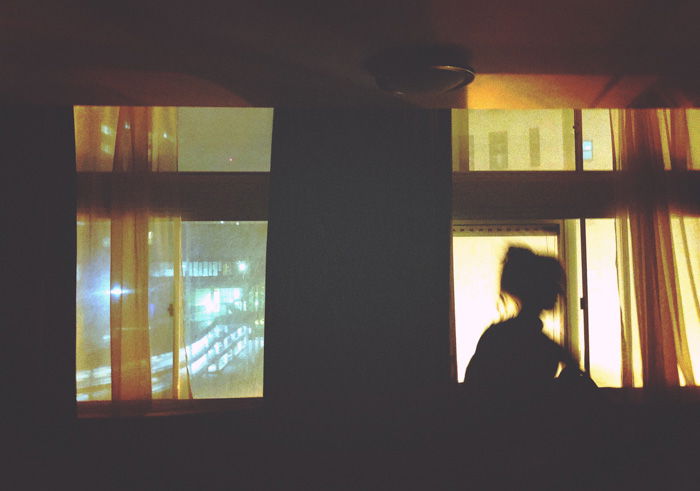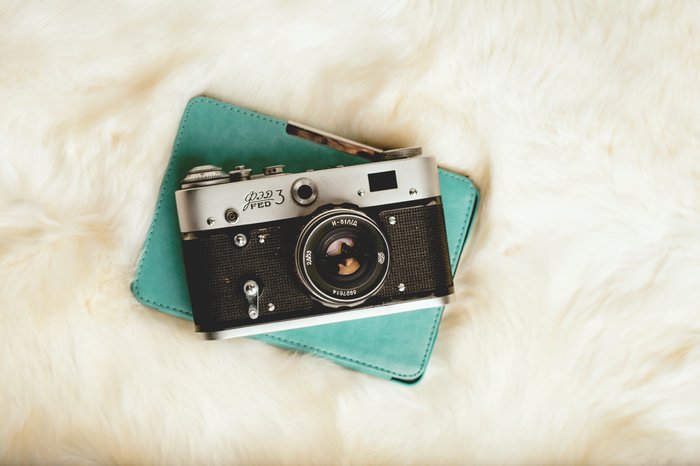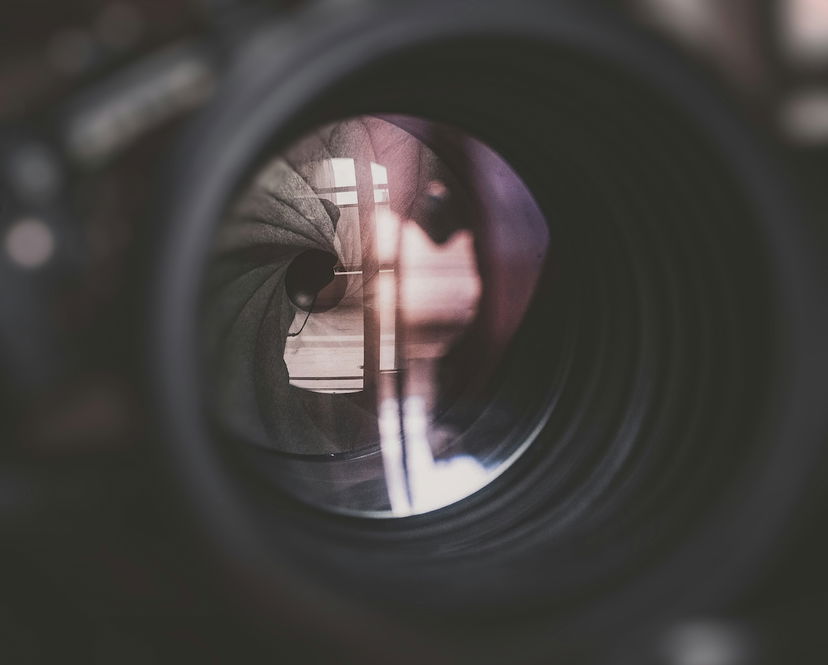What is a DSLR Camera? (DSLR Beginner Guide 2026)
What is a DSLR camera? They were once the standard, most popular camera type by far. Recently, though, DSLRs have been phased out in favor of mirrorless cameras.
But DSLRs are still versatile and offer professional photos with high image quality. Plus, they can also work with an array of interchangeable lenses. So what is a DSLR camera exactly? Read on to find out.
What Is a DSLR Camera?
First of all, what does DSLR stand for?
DSLR is the abbreviation for Digital Single Lens Reflex.
“Digital” means that the camera operates with a fixed digital sensor.
“Single-lens” means the camera uses the same lens for framing, focusing, and taking the photo. This is different from a rangefinder or twin-lens-reflex constructions.
With those latter types, you can’t see the exact view from the lens that will take the shot. Instead, you must rely on other methods to set up the shot.
“Reflex” refers to a system where a mirror splits or directs the incoming light toward the optical viewfinder. It allows you to see an exact optical view of the scene.
This mirror can be fixed and semi-transparent in SLT-type (Single Lens Translucent) cameras. Or it can flip up during exposure (in SLRs and DSLRs).
So what is the difference between a DSLR and SLR camera? Mainly that the former has a digital sensor to record its images. An SLR uses film.
Check out our Photography for Beginners course to learn more about photography basics!
How Does a DSLR Work?
A DSLR system consists of two main elements—a lens and a camera body.
These can be interchanged to an extent. And professional photographers have many lenses and often more than one camera.
Understanding how they work together is not rocket science. It is explained best by showing the way light travels.
First, light hits the lens from the front. Then, it travels through the lens, which shapes it to a form the photographer desires. It then makes its way through the lens mount to the camera.
Then it encounters the main mirror. The mirror reflects most of it upwards to the viewfinder. And a pentaprism or a pentamirror directs it to the viewer’s eye. This lets you see exactly what the lens sees.
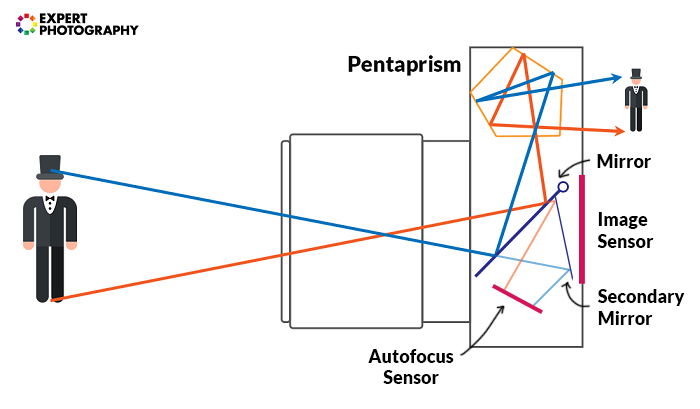
Light traveling through DSLR—to mirror and pentaprism (blue line ) and to the secondary mirror and autofocus sensor (orange line)
In SLRs and DSLRs with autofocus, a small portion of the incoming light actually passes through the main mirror. There, it hits the secondary mirror. This directs it down to the autofocus sensor.
In this state, none of the light hits the imaging sensor. This is a key trait of DSLRs.
The mirrors flip up when you press the shutter button to take a photo. This enables light to hit the sensor. Because the main mirror no longer reflects anything, there is a blackout in the viewfinder.
The shutter mechanism, right in front of the sensor, opens up. It exposes the image and closes down after a set amount of time. That time is called the shutter speed.
After the exposure, the moving parts go back to their previous state.
Why Do You Need a DSLR?
You might wonder, ‘What is the purpose of a DSLR camera?”
First, it is a really well-tested and tried construction. SLRs have been around for a century, and many people associate them with the word “camera.”
A technical advantage of modern SLRs is that they provide a direct, optical view from the lens. So latency or low-light noise in the viewfinder is not an issue.
This is not true with mirrorless, bridge, and compact cameras. And they have had an edge simply because they have been the most widespread camera type.
Plus, their bigger size provides space for more buttons. This allows for faster and more precise manual controls.

DSLRs range from entry-level devices to the highest-quality medium format models. The latter can easily cost you a five-digit sum. Still, the elements are interchangeable.
You could mount a top professional lens on the most basic body. So the options are plenty in every category, for every budget.
The two most popular DSLRs (Canon EF and Nikon F) have over a thousand lenses available. These include lenses made by the brand or third-party manufacturers, like Sigma or Tamron.
You can try an online camera comparison tool to compare the specs and features of DSLR cameras.
What Are the Disadvantages of DSLR Cameras?
DSLRs also have some drawbacks.
First, they are bulky, especially professional DSLRs. The rotating mirrors, the autofocusing sensor, and the complex viewfinder take up a lot of space.
The optical viewfinder also introduces problems. Its display options are very limited.
For instance, you cannot see the current exposure. You can’t judge if your shot will be properly exposed just by looking at an image in the optical viewfinder.
The separate autofocusing sensor can cause headaches, too. Autofocus won’t work accurately if it is misaligned with the image sensor. It might catch focus in front of or behind your subject.
Lastly, most DSLRs use a mechanical shutter, which means they are rated for a certain exposure number before permanently failing.
Are There Other Options?
We will touch on the two most common alternatives for beginners.
Mirrorless Cameras
DSLRs are becoming a thing of the past. The largest recent advancement in photographic technology is high-end mirrorless camera systems.
These are beneficial as there is no mirror action. Mirror flicking affects image stabilization, sound levels, and burst rate.
Without them, we can take photos faster and quieter. Most mirrorless cameras also use an electronic shutter, significantly increasing their lifespan.
They are also lighter, more compact, and have many lens options. Old lenses are easily adapted to them. And they are perfect for any photographic need, from street to time-lapse photography.
Read our article on mirrorless cameras vs DSLRs for more information.
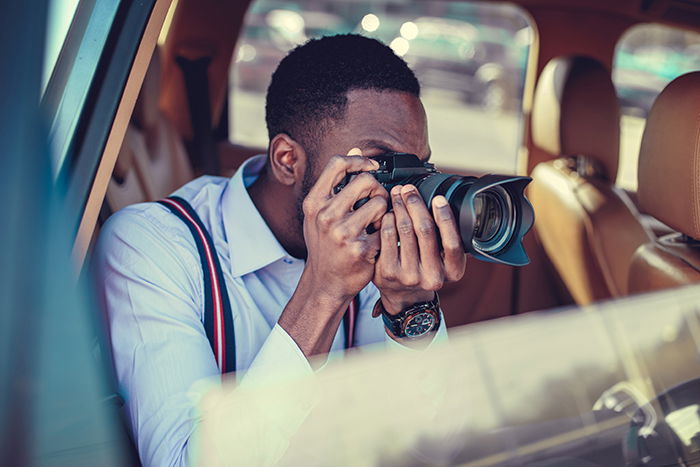 Point-and-Shoot Cameras
Point-and-Shoot Cameras
Point-and-shoot cameras are cheaper and smaller than DSLRs. A point-and-shoot system lets you point it at something and shoot automatically.
Its main benefit is when you shoot street, documentary, or travel photography. It means the camera doesn’t have to be stuck to your eye.
Newer DSLRs cameras have movable LCD screens that allow you to do this. But you still lose out on the size of your device. And a small camera lets you take better candid images than a bigger one.
DSLRs also need you to master manual control of each button to bring the most out of them. A point-and-shoot is built on a different philosophy. It’s ready to go after opening its package.
Plus, they are generally much cheaper. But some advanced models have image quality, controls, and price levels similar to mid-range DSLR cameras. Some even shoot in RAW, like the Ricoh GR IIIx.
You can read our comparison of DSLRs vs point-and-shoots.

Conclusion: What Is a DSLR Camera?
Whatever your budget or subject is, a DSLR is still a solid choice. But be aware that both Canon and Nikon have discontinued their DSLR lines to focus on mirrorless cameras.
DSLR cameras are known for their single-lens mirror system. This lets you preview the exact optical view of the image you will take.
And an advantage of DSLRs is that you can find better deals to fit every budget. And they are still great for professional photographers as they allow great control and provide great images.
To learn more about shooting modes and autofocus, check out our article on understanding your first DSLR article.

